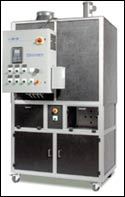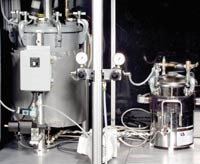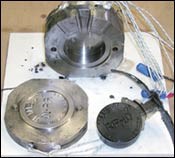Cast Prototypes of Reinforced Nylon 6 Match Injection Molded Quality
A newly developed reactive casting process makes glass-reinforced nylon 6 prototypes and production parts quickly and easily from low-cost molds.
A newly developed reactive casting process makes glass-reinforced nylon 6 prototypes and production parts quickly and easily from low-cost molds. Likely applications are automotive under-hood parts such as intake manifolds, valve covers, water pumps, radiator fins, and fan shrouds, as well as power-tool handles, appliance parts, and electrical enclosures.
The patented process reportedly makes it possible to go from a CAD file to production-quality nylon 6 parts within one to two days and at up to 50% lower cost than with other methods. The new technology allows injection molders of nylon 6 parts to experiment with small production runs and provides an opportunity for prototyping service bureaus to offer low production as well.
Compcast Technologies, LLC of Barnegat Light, N.J., whose company president Matti Holtzberg created the process, holds the rights to license the Compcasting process. Equipment for the process is currently available only through Gusmer Corp., a leading global supplier of plural-component mixing, proportioning, and dispensing equipment for reactive resin systems.
Gravity casting
Compcasting is a no-pressure gravity-casting process. It differs in both equipment and materials from nylon RIM molding technology, which has been around since the 1980s. Through Gusmer, potential users purchase the manufacturing license, which includes a Gusmer RP-10 fiber-reinforced nylon 6 dispensing machine. This manually operated prototype machine can make one part at a time. Results are reportedly equivalent to injection molded parts. The machine sells for $187,000.
Gusmer also plans to offer a turnkey Compcasting cell for $375,000 to $500,000 plus a license fee. This system is more automated and has a larger mixing, metering, and dispensing machine and larger materials tanks, as well as a carousel that can hold up to 30 duplicate molds. Molds will sit on a load cell that will automatically measure the weight of material as the mold fills. With a shot size as large as 1 lb/sec and the ability to feed multiple molds quickly, even large production runs of car parts like intake manifolds could be manufactured 60% faster than comparable injection molded parts, Gusmer says. Such a system costs about one-tenth as much as an injection molding machine.
How it works
The first step is building a mold from a CAD file. Due to the absence of injection pressure when making the part, molds can be made from a variety of low-cost materials, including rubber, epoxy, and low-melting metal alloys. Also suitable are plastic molds made by rapid-prototyping processes such as stereolithography or selective laser sintering, as well as plaster molds made by Z-Corp.’s 3D printer. The cost and long lead times for metal injection molds are eliminated.
Also eliminated is the compounding step to blend nylon 6 resin with fiberglass. The materials used for Compcasting are those for traditional anionic polymerization of nylon 6 from caprolactam. Raw materials include caprolactam monomer from DSM Corp.’s Nipro subsidiary in Augusta, Ga.; activator and catalyst from Pittsburgh-based Bayer Corp.; and milled or chopped fiberglass from Fibertec Inc., Bridgewater, Mass., or Owens Corning in Toledo, Ohio. (Holtzberg recommends these suppliers because they are quite familiar with his process.) Although long-glass fibers can also be used, Holtzberg says, “What we aim to do here is to duplicate an injection molded pellet.”
This simple process does not require high-pressure metering or dispensing pumps like those in a RIM system. The PLC-controlled RP-10 machine first mixes the caprolactam and activator in one tank. The resulting slurry is heated to 300 F and the fiberglass is mixed in via the machine’s agitator. To initiate polymerization and the casting of parts in one operation, the catalyst is dispensed from a separate, smaller, heated tank.
A proprietary ball-type valve under the mixing tank opens to dispense by gravity into the mold. A Zenith gear pump injects heated catalyst from a separate tank into the caprolactam/glass stream at very low pressure just before the mixture enters the mold. Dispensing rate is up to 1 lb/sec. The preheated (300 F) molds are closed when filled.
The polymerization reaction starts as the mixture enters the mold. The material starts out with a viscosity like water and then gels as it polymerizes in the mold. Within 2 to 5 sec, the mixture viscosity changes from 100 cp to 3500, which is thick enough to prevent the glass from settling.
Parts made by Compcasting reportedly have proved to be identical in form, fit, and function to parts fabricated in a high-pressure injection mold. Some industry experts even report that Compcasted nylon 6 parts can outperform injection molded nylon 66 parts in many applications.
Related Content
How to Mount an Injection Mold
Five industry pros with more than 200 years of combined molding experience provide step-by-step best practices on mounting a mold in a horizontal injection molding machine.
Read MoreA Simpler Way to Calculate Shot Size vs. Barrel Capacity
Let’s take another look at this seemingly dull but oh-so-crucial topic.
Read MoreHow to Reduce Sinks in Injection Molding
Modifications to the common core pin can be a simple solution, but don’t expect all resins to behave the same. Gas assist is also worth a try.
Read MoreRead Next
Processor Turns to AI to Help Keep Machines Humming
At captive processor McConkey, a new generation of artificial intelligence models, highlighted by ChatGPT, is helping it wade through the shortage of skilled labor and keep its production lines churning out good parts.
Read MoreTroubleshooting Screw and Barrel Wear in Extrusion
Extruder screws and barrels will wear over time. If you are seeing a reduction in specific rate and higher discharge temperatures, wear is the likely culprit.
Read More


























